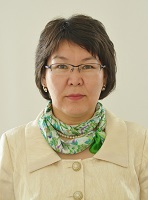Alterations in mindset of modern Buryats: the evidence from psychosemantic studies
DOI:
https://doi.org/10.25178/nit.2017.3.7Keywords:
mindset of ethnos; Buryats; intraethnic tension; psychosemantics; associative row; ethnic identityAbstract
The article examines the changes in the mindset of Buryats from the standpoint of the psychosemantic approach. This qualitative methodology is especially relevant for cross-cultural studies. The authors have conducted a number of studies of value orientations, namely of the core of youth mindset.
In 2009, 60 college students in the city of Ulan-Ude (capital of Buryatia) were asked to assess 22 paintings on different subjects by Buryat artists of mid-20th century. The students were supposed to give their judgments of how marked was the expression of certain values in each painting (a list of values was provided to them). The outcomes were processed through factor analysis. The survey revealed that a clash of values can be observed in Buryats. In their value orientations, modern focus on personal development coexisted with some traditional values, such as social appraisal, and with insensitiveness to others (family ties, respect of parents). A latent intraethnic tension is clearly present – a personal identity status which determines the choice of individual strategy under the mutual interference between the world of archaic ancestral traditions and that of integrated cultures.
A tension in identificational practices was also revealed in 2017 survey of 140 students at Buryat State University. Logging on to the website of associative experiments, they received 104 stimulating words in Buryat language and asked to type in words and phrases triggering associations with the initial concept. This revealed the peculiarities of mindset of modern Buryats (plurality, multi-level identity, from the tribal and most local to the universal; self-consciousness of being “Buryat” with predominance of traditional values, religious syncretism, etc.).
Another cross-cultural study of value orientations among the youth (Buryat and Mongol students, 536 in total) was conducted in 2016-2017. It showed that Buryat youth is generally oriented towards traditional culture. At the same time, the ideology of family clan connections, the mythology of kin, orientation towards “being Buryat” coexists in the minds of youth with a focus on contemporary culture. Researchers documented the two-level structure of self-identifications of Buryat youth, which, in its turn, implicitly reflect their mindset.
Latent intraethnic tension discovered through opinion polling determines the choice of individual strategy in modern society. The positive type of ethnic identification generally prevails in Buryats, while marginal and hyperidentical strategies are found to be “floating” (from erosion and ambiguity of ethnic affiliation to fanatical adherence to it).
References
Budaeva, D. Ts., Khanturgaeva, N. Ts., Tsyrenova, Zh. Zh., Budaeva, Ts. B. and Itigilova, L. M. (2013) Mezhnatsional'nye, religioznye, etnopsikhologicheskie realii Buriatii i voprosy grazhdanskoi aktivnosti naseleniia [Interethnic, religious, ethno-psychological realities of Buryatia and the issues of civil activity of the population]. Ulan-Ude, BGU Publ. 163 p. (In Russ.)
Dugarova, T. Ts. (2010a) Osobennosti etnicheskogo samosoznaniia sovremennykh buriat Rossii [Features of ethnic identity of modern Buryats in Russia]: Diss. … Doctor of Psychology. Moscow. 445 p. (In Russ.).
Dugarova, T. Ts. (2010b) Psikhosemantika etnicheskogo samosoznaniia [Psychosemantics of ethnic identity]. Prepodavatel' XXI vek, vol. 1, no. 1, pp. 160–167. (In Russ.).
Dugarova, T. Ts. (2012) Chelovek v usloviiakh sopriazheniia mezhdu mirom rodovykh traditsii i mirom integratsii kul'tur [Man under conjunction between the world of ancestral traditions and the world of integration of cultures]. Razvitie lichnosti, no. 1, pp. 188–207. (In Russ.).
Dugarova, T. Ts. (2015) Modifikatsii etnicheskogo samosoznaniia: profilaktika ekstremizma v studencheskoi srede [Modification of ethnic identity: preventing extremism among students]. Vestnik Buriatskogo gosudarstvennogo universiteta, no. 5, pp. 49–54. (In Russ.).
Dugarova, T. Ts. and Badiev, I. V. (2017) Kul'turno-tsennostnye orientatsii rossiiskikh (russkikh i buriat) i mongol'skikh studentov [Cultural and value orientations of Russian, Buryat and Mongolian students]. Vestnik Rossiiskogo universiteta druzhby narodov, Series “Psikhologiia i pedagogika”, vol. 14, no. 2, pp. 190–200. DOI: 10.22363/2313-1683-2017-14-2-190-200 (In Russ.).
Lamazhaa Ch. K. (2016) Tuvinskaia etnichnost' i sotsium v etnosotsiologicheskikh i antropologicheskikh issledovaniiakh [Tuvan ethnicity and the society in ethnosociological and anthropological studies]. The New Research of Tuva, no. 2. URL: http://nit.tuva.asia/nit/article/view/93 (access date: 06.07.2017) (In Russ.).
Mukhina, V. and Dugarova, T. (2010) Mental'nye osobennosti sovremennykh buriat Rossii [Mentality features of modern Buryats in Russia]. Razvitie lichnosti, no. 2, pp. 164–175. (In Russ.).
Petrenko, V. F. and Mitina, O. V. (2017) Psikhosemanticheskii podkhod v rekonstruktsii politicheskogo mentaliteta: metody i primery issledovanii [A psychosemantic approach to reconstruction of political mentality: Research methods and examples]. Vestnik Rossiiskoi akademii nauk, vol. 87, no. 1, pp. 50–64. DOI: 10.7868/S086958731701008X (In Russ.).
Filippovich, Iu. N. (2012) Infokognitivnaia tekhnologiia modelirovaniia verbal'nogo soznaniia [Infocognitional technology of modeling verbal consciousness]. Vestnik Novosibirskogo gosudarstvennogo universiteta. Series “Lingvistika i mezhkul'turnaia kommunikatsiia”, vol. 10, no. 2, pp. 51–62. (In Russ.)
Published
How to Cite
Issue
Section

Author(s) license holder(s) grant rights for their work to the journal (grantee of a license) under the simple non-exclusive open license in accordance with Art. 1286.1 «Open license for a research work, work of literature or fine arts», Civil Code of the Russian Federation.
New Research of Tuva publishes articles under the Creative Commons Attribution-NonCommercial license (CC BY-NC).
Since it is an open license, author(s) reserve the right to upload the article to their institutional repository, submit it to another journal (if it allows republications), or republish it on their own website (in full, or in part).
However, several conditions apply here:
a) The republished version must always contain the name(s) and affiliation(s) of the author(s), the original title and the hyperlink to the original version on the New Research of Tuva website;
b) It must be in open access, free of charge, and no category of readers must be in any way whatsoever advantaged over general readership.
c) should the contribution be submitted elsewhere by its author(s) without substantial modification (30% or more of original text unchanged), the body of the article should contain a disclaimer that the original version was published in New Research of Tuva (with a link to the respective page)
The CC-BY-NC is a non-revocable license which applies worldwide and lasts for the duration of the work’s copyright.












